Customers Tab
Manager Menu-Tabs > Sales Tabs > Customers Tab
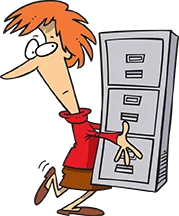
Customer Tab sets up and maintains customer records.
Tasks Performed:
- Maintains a Customer Master File
A Customer is an entity (person, business, or other organization) with whom you have or plan to have an Accounts receivable relationship. Customers are actually subaccounts of Accounts receivable. You must first create a Customer before you can:
- Issue a sales invoice
- Record customer payments
- Generate packing/delivery slips
- Create a customer statement showing balances due or summarizing past transactions
- Issue a credit memo for return of goods
- Generate a sales quote or sales order for future business
- Receive a deposit or advance against future work or delivery of goods
- Record billable time or expenses for later invoicing
- Track your complete sales and receipts history with the customer
Manager's default customer file contains the following customer information (fields) such as:
NameCodeCredit limitCurrency (if activated)Billing addressDelivery addressDivision (if activated)Control account (if activated)Default due date
Note
Manager also allows you to add your own Custom Fields
Customers can be added, changed (edited), viewed, deleted, printed or made inactive.
Not everyone to whom you sell must necessarily be defined as a Customer. You can make a cash sale involving immediate payment without creating a Customer simply by entering the Contact type as Other when receiving money into a bank or cash account. But such transactions will not be recorded in a history for that contact, even if the contact is already defined as a Customer.
To enable the Customers tab, click Customize below the navigation pane, check the box for Customers, and click Update below the list:

Create a Customer
Select the Customers tab, then click the New Customer button:

Complete the entry form. This information will appear on sales invoices and similar documents:
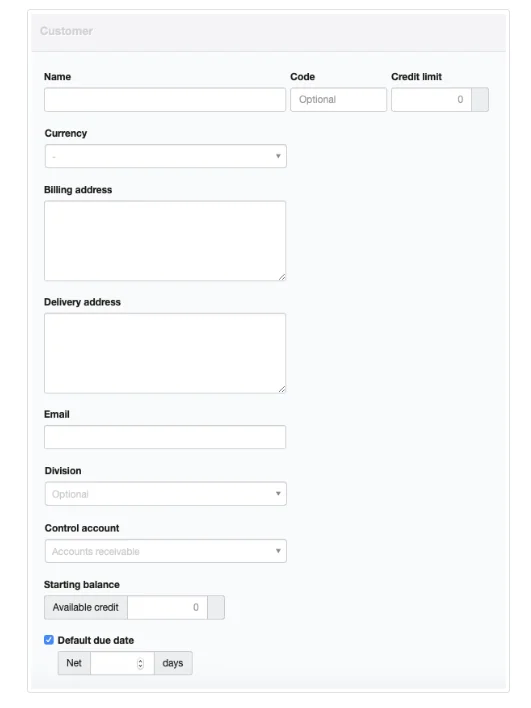
- Name is the legal or billing name of the customer
- Code is a short alphabetic or numeric designation of your customer. If used, the code will appear after the customer’s name on transactions.
- Credit limit is informational. If used, the Customers tab listing will show available credit.
- Currency in which the customer operates can be selected if a foreign currency has been defined for the business. Transactions for the customer will be denominated in the designated currency.
- Billing address should be the mailing address of the customer.
- Delivery address is optional. This field appears only when the Delivery Notes tab is enabled and will be used on delivery notes.
- Email is where documents will be emailed to the customer from within the program.
- Division allows you to assign a customer to a specific division of the business. An unassigned customer will belong to the entire business. The field appears only if divisions are created in the Settings tab.
- Control account allows you to assign the customer to any custom control account made up of customers. Accounts receivable is the default. This field appears only if at least one custom control account for customers is defined.
Note: Starting Balances are no longer entered using this form.
- The Default due date checkbox brings up a Net days field when checked. The number of days indicated will be automatically added to the issue date of any sales invoice created for this customer.
Tip
Even though there's a separate field for an email address, you might want to consider including the customer's email at the bottom of the address field so you can make sending customer statements easier.
Click the Create Button

Your Customer will now appear in the Customers tab.
Note
After adding your first customer, the automatic asset Control Account Accounts receivable is also activated.
Customers are listed in alphabetical order according to their names. Use scrolling, paging, and search functions to find them. The listing shows the number of sales invoices issued to a Customer, value of any uninvoiced items (billable time and expenses), and the Customer’s Accounts receivable balance. Other columns may appear, depending on which tabs are enabled and the setup of any custom fields. Click on blue numbers for more details of any column.
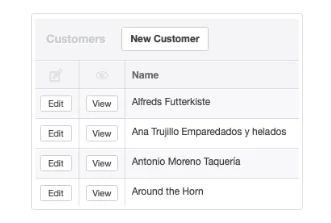
Update Edit Customers
Click the Edit button left of a Customer’s name in the Customers tab to edit or add information. For example, add a Code to make Customers easier to find or distinguish from other Customers with identical names:
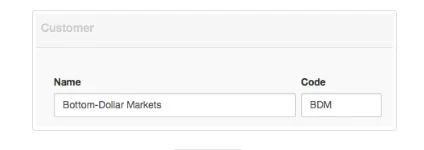
Codes will appear in the Customers tab if any are present:

Codes can also appear on completed forms after the Customer’s name. To see codes on forms, follow instructions in another Guide.
More information can also be placed into the Billing address field, remembering that anything there will appear on invoices.
Example
A customer, Bottom-Dollar Markets, has different billing and delivery addresses. But the Delivery Notes tab is not enabled, so the Delivery address field does not appear. Nevertheless, both addresses can be shown by including them in the Business address field (scroll or expand the box, if necessary, to see all content):
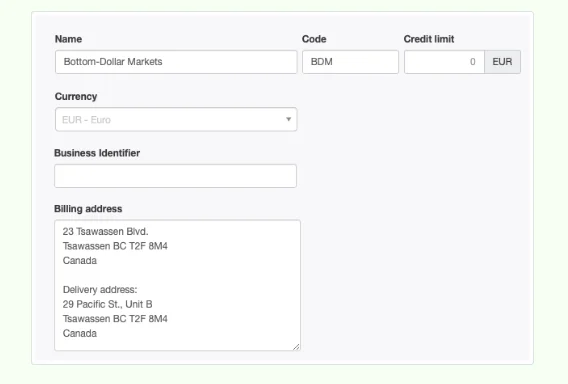
You can also add custom fields for other information about your Customers. Under Settings, click Custom Fields and locate the list for Customers. Click New Custom Field:

Define your custom field. Checkboxes allow you to determine whether the custom field will show as a column in the Customers tab list and on documents. The Position field controls the order in which custom fields appear. Enter a number there, if desired. Click Create at the bottom of the entry screen when finished.
Example
You can add a dropdown list for delivery routes.
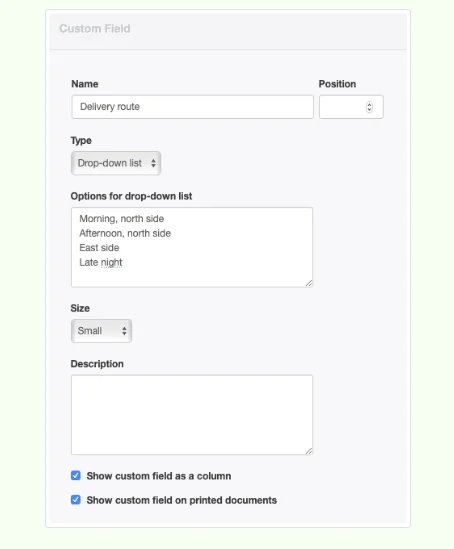
The results of all these changes (including default suppression of the customer code) appear as below:

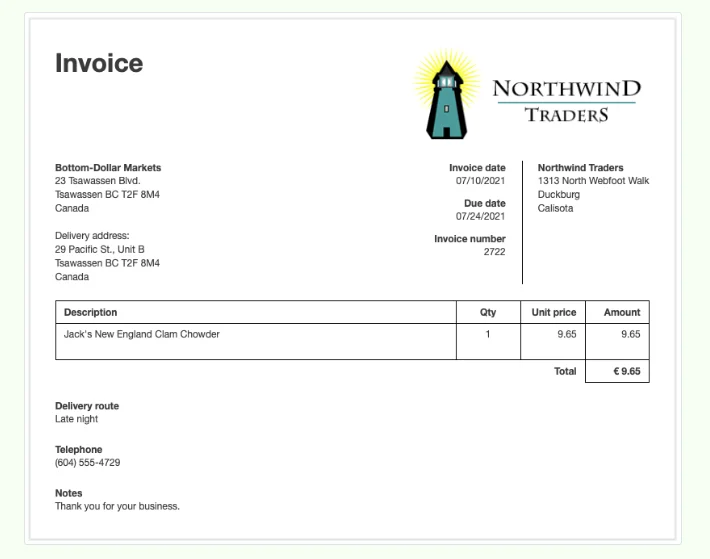
Manage Inactive Customers
Old, inactive Customers can clog your lists. You can delete them if you have never entered any type of transaction for them. Edit the Customer and click Delete at the bottom of the screen. But if you have entered any transactions, Manager will not allow you to delete a Customer, because doing so would also delete all related, historical transactions. Instead, you can make a Customer inactive. Edit the Customer and check the Inactive box. Click Update, and the Customer will no longer appear in the active portion of lists.
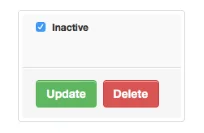
If the Customer ever returns to active status, scroll to the end of the customer list, where you will see inactive customers in light grey text. Click Edit next to the customer’s name:

Uncheck the Inactive box and click Update.
